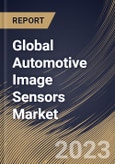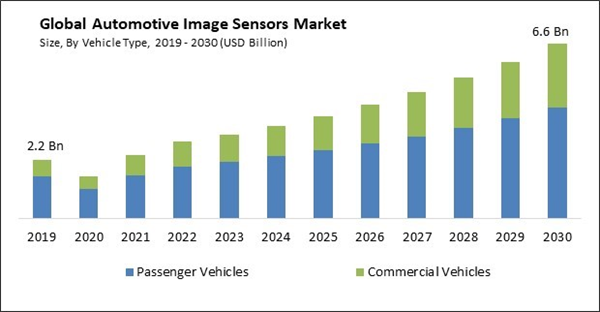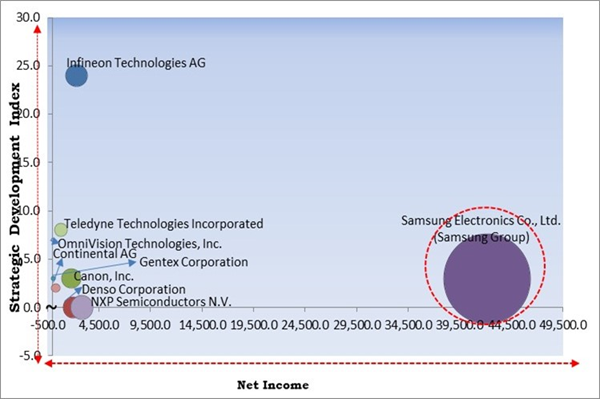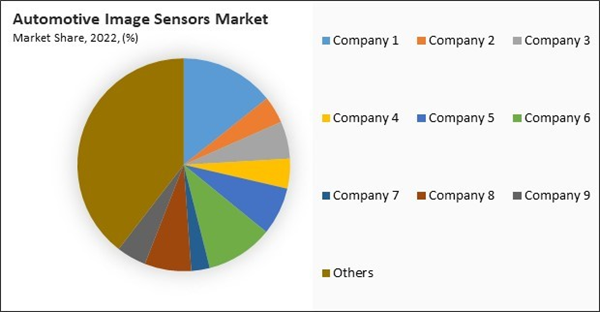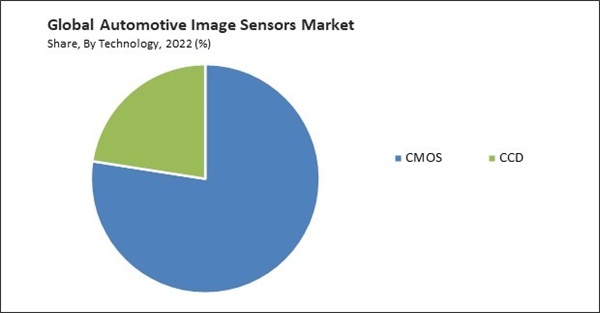The Global Automotive Image Sensors Market size is expected to reach $6.6 billion by 2030, rising at a market growth of 11.1% CAGR during the forecast period. In the year 2022, the market attained a volume of 72,246.4 thousand units, experiencing a growth of 15.3% (2019-2022).
Some countries within the LAMEA region, such as the United Arab Emirates, South Africa, and Brazil, have experienced economic growth and increased urbanization. This has led to an expansion in the automotive industry and consumer demand for advanced vehicles with safety and driver assistance features that rely on image sensors. Hence, the LAMEA region generated $173.6 million revenue in the market in 2022. The growth of ride-sharing and ride-hailing services in urban areas of the LAMEA region is increasing the adoption of image sensor technology. Service providers are looking to enhance vehicle safety and security by using image sensors for driver monitoring and collision avoidance features. These factors will propel the demand in the LAMEA region.
The major strategies followed by the market participants are Product Launches as the key developmental strategy to keep pace with the changing demands of end users. For instance, In October, 2022, Infineon Technologies AG announced the launch of the XENSIV connected sensor kit, a new IoT sensor platform for rapid prototyping and development of customized IoT solutions. This launch aimed at CSK for rapid prototyping of connected IoT sensors. In addition, In July, 2021, Samsung Electronics Co., Ltd. announced the launch of ISOCELL Auto 4AC, an automotive image sensor. The launched product would be optimized for automotive applications.
The leading players in the market are competing with diverse innovative offerings to remain competitive in the market. The above illustration shows the percentage of revenue shared by some of the leading companies in the market. The leading players of the market are adopting various strategies in order to cater demand coming from the different industries. The key developmental strategies in the market are Product Launches and Product Expansions.
The market research report covers the analysis of key stake holders of the market. Key companies profiled in the report include Samsung Electronics Co., Ltd. (Samsung Group), Continental AG, Infineon Technologies AG, Denso Corporation, OmniVision Technologies, Inc., Sharp Corporation (Hon Hai Precision Industry Co., Ltd), NXP Semiconductors N.V., Gentex Corporation, Canon, Inc., and Teledyne Technologies, Inc.
Some countries within the LAMEA region, such as the United Arab Emirates, South Africa, and Brazil, have experienced economic growth and increased urbanization. This has led to an expansion in the automotive industry and consumer demand for advanced vehicles with safety and driver assistance features that rely on image sensors. Hence, the LAMEA region generated $173.6 million revenue in the market in 2022. The growth of ride-sharing and ride-hailing services in urban areas of the LAMEA region is increasing the adoption of image sensor technology. Service providers are looking to enhance vehicle safety and security by using image sensors for driver monitoring and collision avoidance features. These factors will propel the demand in the LAMEA region.
The major strategies followed by the market participants are Product Launches as the key developmental strategy to keep pace with the changing demands of end users. For instance, In October, 2022, Infineon Technologies AG announced the launch of the XENSIV connected sensor kit, a new IoT sensor platform for rapid prototyping and development of customized IoT solutions. This launch aimed at CSK for rapid prototyping of connected IoT sensors. In addition, In July, 2021, Samsung Electronics Co., Ltd. announced the launch of ISOCELL Auto 4AC, an automotive image sensor. The launched product would be optimized for automotive applications.
Cardinal Matrix
Market Competition Analysis
Based on the Analysis presented in the Cardinal Matrix; Samsung Electronics Co., Ltd. (Samsung Group) is the major forerunner in the Market. Companies such as Infineon Technologies AG, OmniVision Technologies, Inc. and Teledyne Technologies Incorporated are some of the key innovators in the Market. In November, 2022, Infineon Technologies AG introduced XENSIV TLE4971 sensor, with a compact design and state-of-the-art sensing. The launched product would provide a precise magnetic current sensing based on proprietary temperature and stress compensation.Market Growth Factors
Stringent safety standards imposed on automotive manufacturing
Safety standards and regulations often mandate the inclusion of specific safety features in vehicles to reduce the risk of accidents and enhance occupant and pedestrian safety. In many places, features that significantly rely on image sensors, such as autonomous emergency braking, lane-keeping assistance, and adaptive cruise control, become required. The need to meet safety regulations and consumer expectations has spurred continuous technological advancements in image sensor technology. Manufacturers are developing image sensors with higher resolution, better low-light performance, and enhanced processing capabilities, ensuring they are well-equipped to meet the requirements of advanced safety systems. Thus, these factors will drive the expansion of the market.Rising popularity of ADAS features in the automobiles
ADAS technologies encompass many safety and convenience features, including adaptive cruise control, lane-keeping assist, blind-spot monitoring, and automatic emergency braking. These features have gained immense popularity among consumers who prioritize safety and convenience. As a result, automakers increasingly integrate ADAS into their vehicle models, driving up the demand for image sensors. One of the primary objectives of ADAS is to enhance safety on the road. Image sensors are essential for meeting these regulatory requirements. As governments and safety organizations worldwide emphasize the importance of ADAS in improving road safety, the positive impact on the image sensor sector extends to a global scale. These factors are expected to propel the demand for automotive image sensors worldwide.Market Restraining Factors
Challenges in retrofitting image sensors in old vehicles
The presence of many older vehicles on the road that lack image sensor-based safety features restricts the potential market for image sensor retrofitting. This limitation reduces the market's expansion opportunities as the retrofitting of older vehicles becomes complex and costly. Retrofitting older vehicles with image sensors and ADAS systems involves complex and intricate installation processes. The challenge of retrofitting older vehicles further segments the market. While newer vehicles come equipped with image sensors as standard or optional features, older vehicles are left with a technology gap. This segmentation can lead to unequal access to safety and convenience features across vehicle segments. These factors are expected to hamper the growth of the market in the upcoming years.The leading players in the market are competing with diverse innovative offerings to remain competitive in the market. The above illustration shows the percentage of revenue shared by some of the leading companies in the market. The leading players of the market are adopting various strategies in order to cater demand coming from the different industries. The key developmental strategies in the market are Product Launches and Product Expansions.
Technology Outlook
Based on technology, the market is segmented into CCD and CMOS. In 2022, the CCD segment garnered a significant revenue share in the market. CCD sensors are known for their higher image quality and offer high-resolution images with low noise and high dynamic range. These characteristics make them suitable for demanding applications in the automotive sector, such as advanced driver assistance systems and autonomous vehicles, where image quality and accuracy are critical. CCD sensors perform exceptionally well in low-light conditions. This is crucial for night vision, pedestrian detection, and object recognition in automotive applications. Therefore, the segment will witness an increased demand in the future.Vehicle Type Outlook
On the basis of vehicle type, the market is bifurcated into passenger vehicles and commercial vehicles. The passenger vehicles segment recorded the maximum revenue share in the market in 2022. Passenger vehicle buyers are increasingly prioritizing safety features when making purchasing decisions. Image sensors enhance safety by providing real-time information about the vehicle's surroundings, helping drivers avoid accidents and collisions. This has driven automakers to integrate advanced image sensor-based safety systems. Modern passenger vehicles are increasingly equipped with connectivity features that rely on image sensors. In-cabin monitoring systems, gesture control, and augmented reality displays are becoming common in new vehicle models.Regional Outlook
By region, the market is segmented into North America, Europe, Asia Pacific, and LAMEA. The Asia Pacific segment procured the highest revenue share in the market in 2022. The Asia Pacific region is a global hub for the automotive industry. It has witnessed substantial growth in vehicle production, making it a critical market. The demand for image sensors increases as vehicle manufacturing grows in nations like China, India, South Korea, and Japan. One such use is advanced driver assistance systems, which use image sensors. Therefore, Asia Pacific is expected to grow rapidly in the coming years.The market research report covers the analysis of key stake holders of the market. Key companies profiled in the report include Samsung Electronics Co., Ltd. (Samsung Group), Continental AG, Infineon Technologies AG, Denso Corporation, OmniVision Technologies, Inc., Sharp Corporation (Hon Hai Precision Industry Co., Ltd), NXP Semiconductors N.V., Gentex Corporation, Canon, Inc., and Teledyne Technologies, Inc.
Strategies deployed in the Market
Partnerships, Collaborations, and Agreements:
- May-2023: Infineon Technologies AG came into partnership with Hon Hai Technology Group, the world’s largest electronics manufacturing services provider. This partnership aimed to develop advanced electromobility with efficient and intelligent features.
- Mar-2023: OmniVision Technologies, Inc. partnered with Eyeris Technologies, Inc., a global leader for automotive in-cabin sensing AI and sensor fusion solutions. This partnership aimed to integrate the OMNIVISION OAX4600 system-on-chip platform and its OX05B1S 5-megapixel RGB-IR global shutter sensor.
- Mar-2023: Infineon Technologies AG signed an agreement with Delta Electronics, Inc., the world-leading power and energy management company based in Taiwan. Under this agreement, both companies aimed to offer more efficient and higher-density solutions for the fast-growing market of electric vehicles.
- Jun-2022: Infineon Technologies AG collaborated with PMD Technologies, a developer of CMOS semiconductor 3D time-of-flight components. Under this collaboration, both companies would develop the second generation of the REAL3 automotive image sensor, a compliant high-resolution 3D image sensor.
- Jun-2022: Teledyne e2v collaborated with Tower Semiconductor Ltd., a leading foundry of high-value analog semiconductor solutions and provides technology and manufacturing platforms for integrated circuits (ICs). This collaboration aimed to launch Topaz CMOS image sensors, utilizing Tower Semiconductor’s 65nm global shutter pixel technology.
- Jan-2020: OmniVision teamed up with Artilux, the pioneer of wide-spectrum 3D sensing technology based on GeSi photonics. Together, the companies announced the collaboration in the area of CMOS image sensors and GeSi-based 3D sensors, after a series of evaluations & analyses.
- Jan-2020: Gentex Corporation collaborated with Aston Martin, the iconic luxury British sports car manufacturer. This collaboration aimed to develop a camera-based rear-view system that would be used in future Aston Martin models.
Product Launches and Product Expansions:
- Sep-2023: OmniVision Technologies, Inc. launched the OX08D10 8-megapixel (MP) CMOS image sensor with TheiaCel technology. The launched product would improve automotive safety by offering enhanced resolution and image quality in exterior cameras for advanced driver assistance systems (ADAS) and autonomous driving (AD).
- Nov-2022: Infineon Technologies AG introduced XENSIV TLE4971 sensor, with a compact design and state-of-the-art sensing. The launched product would provide precise magnetic current sensing based on proprietary temperature and stress compensation.
- Oct-2022: Infineon Technologies AG announced the launch of the XENSIV connected sensor kit, a new IoT sensor platform for rapid prototyping and development of customized IoT solutions. This launch aimed at CSK for rapid prototyping of connected IoT sensors.
- May-2022: Continental AG introduced the Current Sensor Module (CSM) and the Battery Impact Detection (BID) system, new sensors for electrified vehicles. The launched solutions would focus on safeguarding the battery or on battery parameter retention.
- Jul-2021: Samsung Electronics Co., Ltd. announced the launch of ISOCELL Auto 4AC, an automotive image sensor. The launched product would be optimized for automotive applications.
- May-2020: Teledyne e2v launched Emerald 3.2 MP CMOS image sensor. This sensor is designed to face the challenges of evolving applications like drones, security, embedded vision, and traditional machine vision.
Scope of the Study
Market Segments Covered in the Report:
By Technology (Volume, Thousand Units, USD Million, 2019-2030)- CMOS
- CCD
- Passenger Vehicles
- Commercial Vehicles
- North America
- US
- Canada
- Mexico
- Rest of North America- Europe
- Germany
- UK
- France
- Russia
- Spain
- Italy
- Rest of Europe- Asia Pacific
- China
- Japan
- India
- South Korea
- Singapore
- Malaysia
- Rest of Asia Pacific- LAMEA
- Brazil
- Argentina
- UAE
- Saudi Arabia
- South Africa
- Nigeria
- Rest of LAMEA
Key Market Players
List of Companies Profiled in the Report:
- Samsung Electronics Co., Ltd. (Samsung Group)
- Continental AG
- Infineon Technologies AG
- Denso Corporation
- OmniVision Technologies, Inc.
- Sharp Corporation (Hon Hai Precision Industry Co., Ltd)
- NXP Semiconductors N.V.
- Gentex Corporation
- Canon, Inc.
- Teledyne Technologies, Inc.
Unique Offerings
- Exhaustive coverage
- The highest number of Market tables and figures
- Subscription-based model available
- Guaranteed best price
- Assured post sales research support with 10% customization free
Table of Contents
Chapter 1. Market Scope & Methodology
Chapter 2. Market At a Glance
Chapter 3. Market Overview
Chapter 4. Competition Analysis - Global
Chapter 5. Global Automotive Image Sensors Market, By Technology
Chapter 6. Global Automotive Image Sensors Market, By Vehicle Type
Chapter 7. Global Automotive Image Sensors Market, By Region
Chapter 8. Company Profiles
Companies Mentioned
- Samsung Electronics Co., Ltd. (Samsung Group)
- Continental AG
- Infineon Technologies AG
- Denso Corporation
- OmniVision Technologies, Inc.
- Sharp Corporation (Hon Hai Precision Industry Co., Ltd)
- NXP Semiconductors N.V.
- Gentex Corporation
- Canon, Inc.
- Teledyne Technologies, Inc.
Methodology

LOADING...


